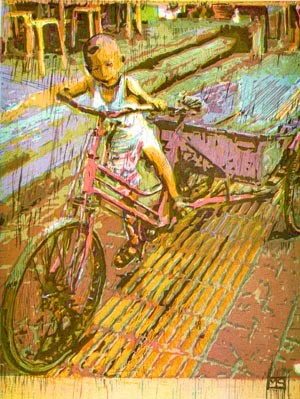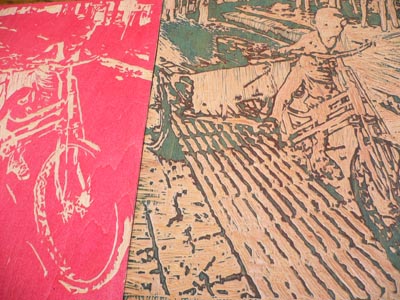Q: Max, your color woodblock “Untitled,†(Bike) is a knockout – how did you achieve the amazing effects?
amazing effects?
A: Untitled, 9×12, was a seven run print, five separate woodblocks with two reduced states one on the second and one on the fourth in the print sequence; edition of 15. The final number of colors in the piece I roughly estimate to be around 40, maybe more. This was achieved by applying CMYK color separation technology to a photographic source and then separating each channel into a duotone of that color except for the key layer. This information was then hand copied and carved out of Japanese shina wood and printed in hand-mixed oil-based inks in sequence.
Q: Where did you develop your skill with multiple woodblocks?
A: I developed my skill with multiple woodblocks primarily under the guidance and motivational support of UCSC Lecturer Paul Rangell. Richard Wohlfeiler, another UCSC teacher also played a large role in opening my mind to the possibilities of the medium, and gave me the technical support needed to realize the completion of the seemingly impossible projects I had imagined.
I spent a great deal of time in mainland China and Hong Kong studying ink painting under the guidance of my teachers, including Ming Ren. My time spent studying ink painting really helped me to develop an appreciation for very ancient forms of art making and the traditions surrounding them. It was learning the value of this that led me to understand the value of the woodblock in this age.
 Q: What intrigues you most about this ancient, esoteric medium?
Q: What intrigues you most about this ancient, esoteric medium?
A: The most immediate engagement is the visceral pleasure I derive from carving the wood itself: the feel of it, the sound of it, the grain and look of it, even the smell of it. The broader level of my interest comes from a desire to make multiples of original artwork which pay certain homage to the aesthetic considerations and sensibilities of the Japanese masters as well as the Chinese. All printmaking has a kind of esoteric technical craft and language which I love, but of all the print mediums I feel the woodblock is most to the point. The woodblock print was born as an art form designed to be attainable by the everyday populace, and although with its contemporary revival it has lost the necessity of this fundamental drive, it still contains it at its essence.
Q: Are you consciously working against the digital tide?
A: I don’t feel that I am working against the digital tide; rather I feel the desire to bridge the gap between the old and the new. I see the digital advances in the arts of this generation as something which was fundamentally born out of the old traditions of printmaking, and is growing in a direction from which its roots are becoming invisible. In a sense the digital print is the biggest threat to the analog print as far as widespread appreciation is concerned. From this perspective analog revival seems paramount, and for those who feel this way I think the tendency is to refuse the digital. But digital technology is also an extremely powerful tool. My goal through the fusion of the very ancient woodblock print, and the contemporary digital print, is in a sense to humanize the technology of today, while simultaneously reinforcing the value of the dying ancient traditions. I don’t believe there is a right direction, only that to move ahead and forget the past is blindness, and to remember the past and not see the present is paralysis.
Q: Do you have “a day job?” or is this it – art, art, art.
A: At this point I do not have a job. I am fortunate enough to be able to focus on my artwork. I am actively beginning collaboration with a few professors, and continuing my research with them into more experimental forms of printmaking. This includes furthering the CMYK woodblock print to the point of a 16-color separation, the development of rust as print medium and specifically the advent of a rust photograph, and also the revival of a lithographic process from the 1850’s similar to the collotype by concocting a photo emulsion out of egg whites which can be applied to the stone directly to create a matrix from which photographic exposures can be achieved.
Q: Whose work do you admire, or engage in dialogue with? (living or dead)
A:I greatly admire and want to pay tribute to the work of Katsushika Hokusai, Tsukioka Yoshitoshi, Utagawa Hiroshige, and Hiroshi Toshi, Yoshida Toshi (father and son). Also much of my aesthetic considerations come from the writings of Jun’ichiro Tanizaki specifically his thesis on Japanese aesthetics In praise of Shadows. Of the Western artists, mainly Albrecht Dürer and Goya. Also many of my close friends have played a very large role in my artistic pursuits as far as collaboration and the creative process are concerned.(See more Max Stadnik work at his website.)

